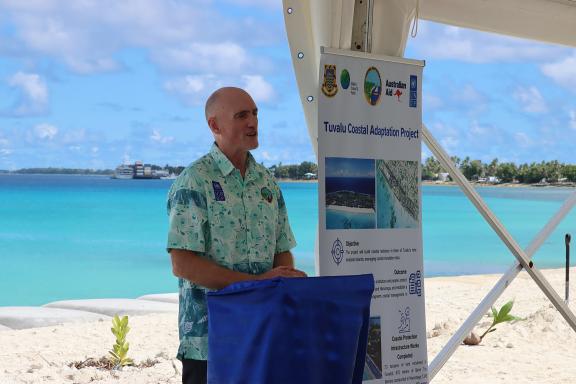A sliver of hope from the middle of the Pacific Ocean
Standing on this sliver of land in the middle of the vast Pacific Ocean, I was on the frontline of the climate crisis literally.
Sixty metres from one side of the island to the other. Sixty metres from the ocean to the lagoon. Sixty metres from rising sea levels, more powerful and unpredictable storms, and increasingly powerful King Tides.
Welcome to Funafuti, the capital of the atoll nation of Tuvalu, where half of the country’s 11,300 inhabitants live.
This was my first mission as a representative of the Green Climate Fund (GCF). It was a proud moment; I was here to witness the handing over of new land – reclaimed as a result of GCF investment – to the national government.

GCF Senior Media Specialist Andrew McElroy speaking at the project’s handover ceremony in Tuvalu. Photo: UNDP Pacific
The USD 38.9 million Tuvalu Coastal Adaptation Project has constructed 7.3 hectares of raised, storm-resilient, flood-free land in the heart of Funafuti.
GCF’s mandate is to support transformative climate action. On the ground in the middle of the Pacific Ocean – about halfway between Australia and Hawaii – was an example of actions matching words.
7.3 hectares or 0.073 square kilometres may not sound much, but this is a big deal in a country whose total land mass across nine islands is only 26 square kilometres.
The new land is the largest safe zone in the capital of one of the world’s most climate-vulnerable countries, and plans are afoot to construct government offices, houses, recreational areas, and other critical infrastructure.


The pioneering ‘vertical adaptation’ project has attracted millions of dollars in additional investment and opened up new land use and livelihood opportunities for the Tuvaluan population. Photo: GCF/Andrew McElroy
How big a deal this is soon became apparent as I chatted on the new seafront with Dr. Arthur Webb, the Pacific’s foremost authority on adaptation in atoll nations. He is also a leading member of the UNDP team that oversaw the project's implementation.
Remarkable as it may seem, Dr. Webb explained that before the project, it was not known that the average height of land in Tuvalu was only 0.5 metres above high tides across the nation.
The project “has enabled planning that is actually commensurate with what the science explains will be the impacts of climate change, and thus, framing the scale of what must be done,” he said.
State-of-the-art aeroplane-mounted technology, known as Light Detection and Ranging (LIDAR), collected precise information on land surface height and seafloor depth that informed the vertical engineering.

Dr. Webb, the Pacific’s foremost authority on adaptation in atoll nations, said that GCF investment has led to a paradigm shift in thinking and understanding regarding ambitious but viable long-term climate adaptation planning. Photo: GCF/Andrew McElroy
Inaction poses an existential threat to Tuvalu. By 2050, half of the capital Funafuti will be inundated by daily high tides, and by 2100, 95 per cent of the land area will be flooded by routine high tides.
Amid this escalating climate risk, the project provides options for Tuvalu and Tuvaluans to choose a more secure and prosperous future. It has been wonderful to see that the project’s success has attracted millions of dollars in additional investment for further land reclamation in the capital.
As the Minister of Home Affairs, Climate Change, and Environment for the Government of Tuvalu Dr. Maina Talia said, "This project stands as a symbol of hope that through innovation, cooperation, and determination, small island nations like Tuvalu can find ways to thrive in the face of climate change. It reminds the world that while we may be among the most vulnerable to climate change, we are also among the most innovative and resilient in finding solutions".
By Andrew McElroy, GCF Senior Media Specialist